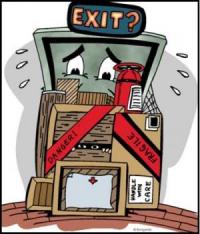This is an archive of news stories and research from the National Union of Public and General Employees. Please see our new site - https://nupge.ca - for the most current information.
Are you prepared for an emergency in the workplace? Who do you contact in case of fire or other disaster? Where are the emergency exit routes for your work area?
 When calling for help, the emergency response team needs to know:
When calling for help, the emergency response team needs to know:
Where is the emergency? Give complete directions, including city, street address, unit number, and nearby landmarks.
What is the emergency? The person at the other end of the call won’t know what equipment to send out unless you briefly describe what happened.
How many people are, or could be, hurt? The dispatcher will need to know this to decide which ambulances and medics to send to the scene.
What types of injuries might there be? Has someone been burned - by flame or by chemicals? Is there a broken bone? Heart attack? Shock? Severe bleeding?
Don’t hang up the phone until the dispatcher tells you to. Spectators can be put to work directing traffic, cleaning hazards, or guiding the rescue team to the site.
Preparing for a Crisis
A sudden crisis can turn your workplace upside down, such as the sour gas explosion that killed a 24-year-old oil well worker in Alberta last year.
Confusion and panic are often the first obstacles when an unplanned event presents a serious risk to life or limb. That's why an organized approach is the essential ingredient of an emergency response plan.
The law requires many such plans. For example, they must be in place for sites where hydrogen sulfide is present, and for operations where oil spills might occur.
Emergencies at an oil and gas worksite can include:
- injuries or fatalities
- leaks and spills
- blowouts
- fires and/or explosions
- natural disasters
- vehicle or aircraft incidents
- confined space rescues
Plans should be in place for all possible emergencies. Minor emergencies include small fires or injuries that can be dealt with by on-site personnel. It's essential that all workers at the site be aware of these plans and practice their individual roles.
The first step in developing a typical emergency response plan is to list all potential hazards, including fires, explosions, sour gas releases, well blowouts and natural disasters. Then identify the possible consequences of each hazard.
The appropriate response, be it evacuation, rescue or spill containment, should be determined. Also prepare an inventory of resources needed, for example, medical supplies, rescue equipment and personnel.
There should be a written description of all steps to be taken in response to each type of emergency. All on-site personnel should have their responsibilities defined and be provided with a copy of the plan.
Occupational safety and health regulations for your region can determine how many people should have first aid training and what supplies are required. Emergency telephone numbers should be posted near every phone.
A disciplined approach to an emergency should include the following steps:
- Protect yourself first.
- Sound the alarm and call for help.
- Isolate the emergency area.
- Assess the hazards.
- Establish a plan of attack.
- Control the threat.
- Clean up, decontaminate and dispose of waste properly.
- Document the incident.
Once emergency plans are in place, periodic drills should be performed and plans updated whenever work procedures, equipment or regulatory requirements change.
Remember, if you fail to plan, you plan to fail. Don't be caught off guard when disaster strikes
